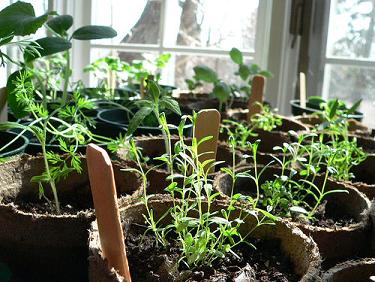
For those of you in colder zones like mine, you’ve probably just recently planted your seeds. I just planted my first couple flats a few weekends ago, and I want to give a few tips on how to make your seed starting successful. First of all, I just want to tell you that I’m not one of those people who create their own specialized soil mixtures. I don’t have that much time or experience- yet. These tips are fast and easy to follow.
The Mixture:
You don’t want to use heavy soil to start seeds in. The tiny roots won’t be able to grow very well, if they’re trying to fight their way through really dense soil. I purchased a bag of organic potting soil, and a bag of perlite. I mixed it about half and half. The soil should crumble easily in your hands, not stick together.
The Temperature:
I always read the seed packets before planting, but I’ve found that the majority of seeds I’ve sown have preferred warm temperatures, usually between 65-75 degrees. If you keep your house much cooler than this, you may want to consider a heating mat to put your flats on. Otherwise, a bright window may do the trick.
The Lighting:
Again, checking the seed packets is important for this. I’ve actually had some seeds that need darkness to germinate, so remember to check out the light preferences. Otherwise, most seedlings prefer bright light. If you’re in an area where you get little bright light, grow lights are definitely a good choice! I haven’t had a space to use grow lights yet, but I may try using one later on this spring.
The Water:
I usually dampen the peat pots with a spray bottle of water before I fill them with dirt. This just prevents them from soaking up all the moisture from the dirt. Once I’ve planted all of the seeds, I give all of them a good misting with the spray bottle again.
Transplanting:
This part can be kind of tricky. Once your little seedlings become established, you need to get them ready for moving outside. It’s important to harden off your seedlings before leaving them out for good. Start bringing them outside when the weather is fairly mild for an hour or so per day. Over the course of about two weeks, gradually increase the amount of time they spend outside, including breezy or rainy days.
The day you actually transplant your seedlings outside should be slightly overcast, or lightly rainy. This will help ease the shock for your little plant.
Remember:
While these tips make seed starting sound so easy, I know sometimes there are seedlings that don’t seem to grow like they should. I’ve killed about the same amount of seedlings as I’ve been successful with. So don’t get discouraged if some of your seedlings die; it’s part of the learning experience!
I want to hear from you!
So, I want to hear from you. What is your seedling story? What seeds are you starting this year? I’d love to hear more about what everyone is doing this spring!
April showers bring May flowers!
Photo credit: sa_ku_ra